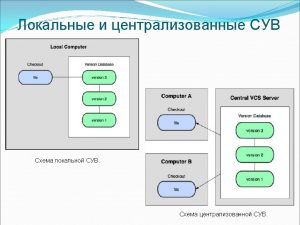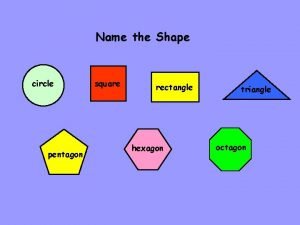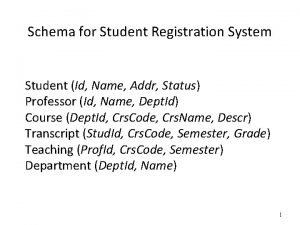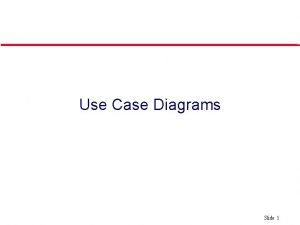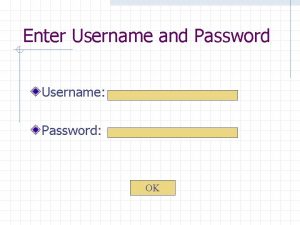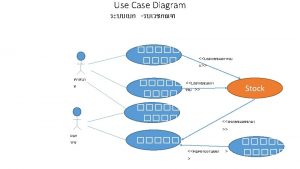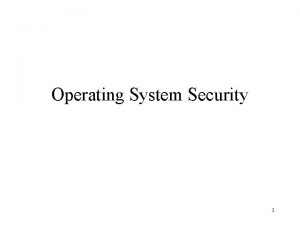n id user Name username user Name user





![예제 : id. java 1 class id { 2 public static void main(String args[]) 예제 : id. java 1 class id { 2 public static void main(String args[])](https://slidetodoc.com/presentation_image_h/37514a6b07d3eef58e84ae92ddd8e87e/image-6.jpg)















![예제: Equal. java 1 public class Equal { 2 public static void main(String args[]) 예제: Equal. java 1 public class Equal { 2 public static void main(String args[])](https://slidetodoc.com/presentation_image_h/37514a6b07d3eef58e84ae92ddd8e87e/image-22.jpg)




![예제: Gauss. java 1 class Gauss { 2 public static void main(String[] args) { 예제: Gauss. java 1 class Gauss { 2 public static void main(String[] args) {](https://slidetodoc.com/presentation_image_h/37514a6b07d3eef58e84ae92ddd8e87e/image-27.jpg)
















![예제 args[3] java Hello. Somebody CHOI KIM T args[0] args[1] 예제 args[3] java Hello. Somebody CHOI KIM T args[0] args[1]](https://slidetodoc.com/presentation_image_h/37514a6b07d3eef58e84ae92ddd8e87e/image-44.jpg)





















![예외 전파: 예제 public class Propagation_Demo { static public void main (String[] args) { 예외 전파: 예제 public class Propagation_Demo { static public void main (String[] args) {](https://slidetodoc.com/presentation_image_h/37514a6b07d3eef58e84ae92ddd8e87e/image-66.jpg)





- Slides: 71




자바 식별자 n 올바른 식별자의 예 id user. Name user_name _user. Name $user. Name n 틀린 식별자의 예 user name 3 d_studio this #arg

키워드 n 자바의 키워드 abstract boolean break byte case catch char class const continue n default do double else extends finally float for goto if implements import instanceof interface long native new package private protected public return short static super switch synchronized this throws transient try void volatile while 주의 1) const와 goto는 예약어로 지정됐지만 현재 사용되지 않는다. 2) "true", "false", "null" 은 boolean/null 상수로 예약어처럼 사용가능 3) 문자가 자바 문자나 숫자인가를 알아보기 위해서는 Character. is. Java. Letter. Or. Digit() 메소드를 이용할 수 있다. 4) 유니코드에 관한 정보는 http: //www. unicode. org/에서 얻을 수 있다.
![예제 id java 1 class id 2 public static void mainString args 예제 : id. java 1 class id { 2 public static void main(String args[])](https://slidetodoc.com/presentation_image_h/37514a6b07d3eef58e84ae92ddd8e87e/image-6.jpg)
예제 : id. java 1 class id { 2 public static void main(String args[]) { 3 String 이름 = "홍길동"; 4 System. out. println("안녕하세요. " + 이름 +" 님!"); 5 } 6 } n 결과 % javac id. java % java id 안녕하세요. 홍길동 님!

예제 : Name. Test. java n 클래스, 메소드, 멤버필드의 이름 공간이 분리 n 클래스, 메소드, 멤버필드의 이름이 동일해도 됨 1 class Same. Name. Point x, y; 2 3 class Name. Test { 4 5 static Same. Name. Point(int x, int y) { 6 Same. Name. Point p = new Same. Name. Point(); . . . 11 public static void main(String[] args) { 12 int Same. Name. Point; 13 Same. Name. Point[] pa = new Same. Name. Point[2]; 14 for (Same. Name. Point = 0; Same. Name. Point++) { 15 pa[Same. Name. Point] = new Same. Name. Point(); . . . < 2;

예제 : Break. Label. java n break/continue에서 사용되는 레이블 n n 변수와 다른 이름 공간을 갖는다. 라벨과 변수의 이름이 동일해도 무방 1 class Break. Label { 2 public static void main(String args[ ]) { 3 i: 4 for (int i = 0; i <= 100; i++) { 5 int j = 0; 6 while (j < 10) { 7 j++; …………. . .




int 타입 n n 32비트 정수 타입으로 -231 ~ 231 -1 사이의 값을 가진다. 예제 : Int. java 1 class Int { 2 3 public static void main(String ard[]) { 4 int 1 = 5, int 2 = 28; 5 int 3, int 4, int 5 ; 6 7 int 3 = int 2 * int 1; 8 int 4 = int 2 / int 1; 9 int 5 = 25 / int 1; 10 11 System. out. println("28 * 5 = "+ int 3); 12 System. out. println("28 / 5 = "+ int 4); 13 System. out. println("25 / 5 = "+ int 5); 14 } 15 }

byte, short 타입 n byte와 short도 int와 마찬가지로 정수 타입이다. byte는 -27 ~ 27 -1 사이의 값 short은 -215 ~ 215 -1 사이의 값 n 예제 : Byte. java n n 1 class Byte { 2 public static void main(String args[]) { 3 byte 1; 4 5 byte 1 = 256; 6 System. out. println("byte 1 = "+byte 1); 7 8} }


예제 : Floating. One. java 1 class Floating. One { 2 public static void main(String args[]) { 3 float 1; 4 5 float 1 = 3. 14; 6 } 7 } n 결과 % javac Floating. One. java: 5: Incompatible type for =. Explicit cast needed to convert double to float 1 = 3. 14; ^ 1 error

예제 : Floating. Four. java 1 class Floating. Four { 2 public static void main(String args[]) { 3 int 1; 4 float 1 = 28. 0 f, float 2 = 5; 5 6 int 1 = (int)(float 1 / float 2); 7 System. out. println("(int)(28. 0 / 5. 0) = "+int 1); …………. . n 결과 % java Floating. Four (int)(28. 0 / 5. 0) = 5

char 타입 n char 타입은 16 비트의 부호가 없는 유니코드로 정의 n 예제: Char. One. java 1 class Char. One { 2 public static void main(String args[]) { 3 char c = 'a'; 4 int 1 ; 5 6 int 1 = c; 7 System. out. println("int 1 = "+ int 1); 8 9 int 1 = int 1 + 1; 10 System. out. println("int 1 = "+ int 1); 11 System. out. println("(char)"+ int 1 +" = "+ (char)int 1); ……… n 예제: Char. Two. java 1 class Char. Two { 2 public static void main(String args[]) { 3 char han = 'ud 55 c'; 4 char gul = 'uae 00’; ……. .



참조 타입 n C++과 자바에서 객체를 생성하는 방법 1 2 3 4 int a = 100 ; Car mycar, yourcar; mycar = new Car(); yourcar = mycar;

![예제 Equal java 1 public class Equal 2 public static void mainString args 예제: Equal. java 1 public class Equal { 2 public static void main(String args[])](https://slidetodoc.com/presentation_image_h/37514a6b07d3eef58e84ae92ddd8e87e/image-22.jpg)
예제: Equal. java 1 public class Equal { 2 public static void main(String args[]) { 3 String a = new String("abc"); 4 String b = "abc"; 5 String c = b; 6 String d = a; 7 8 String. Buffer e = new String. Buffer("abc"); 9 String. Buffer g = e; 10 11 if(a = = b) { 12 System. out. println("a= =b"); 13 } 14 // if(a = = e) { // 컴파일 에러 15 // System. out. println("a= =e"); 16 // } …………. . .

예제: Equal. java 20 if(b. equals(a)) { 21 System. out. println("b. equals(a)"); 22 } 23 if(b. equals(e)) { 24 System. out. println("b. equals(e)"); ……………. . . n 결과 % java Equal c==b b. equals(a)



![예제 Gauss java 1 class Gauss 2 public static void mainString args 예제: Gauss. java 1 class Gauss { 2 public static void main(String[] args) {](https://slidetodoc.com/presentation_image_h/37514a6b07d3eef58e84ae92ddd8e87e/image-27.jpg)
예제: Gauss. java 1 class Gauss { 2 public static void main(String[] args) { 3 int[] ia = new int[101]; 4 for (int i = 0; i < ia. length; i++) 5 ia[i] = i; 6 7 int sum = 0; 8 for (int i = 0; i < ia. length; i++) 9 sum += ia[i]; 10 ………. . .



예제: Multi. Darray. java n 1 class Multi. Darray { 2 public static void main(String args[]) { 3 char stars[][]; 4 5 stars = new char[6][]; 6 for(int i=0; i < stars. length; i++) { 7 stars[i] = new char[i+1]; 8 for(int j=0; j < stars[i]. length; j++) { 9 stars[i][j] = '*'; 10 } ………….












if 문 n 자바의 제어 구조는 C나 C++와 거의 동일 n 형태 1: if (boolean) { statements; } else { statements; } n 형태 2: if (boolean) { statements; } else if(boolean) { statements; } else { statements; }

예제: Hello. Somebody. java 1 class Hello. Somebody { 2 3 public static void main (String args[]) { 4 5 System. out. print("Hello "); 6 if (args. length > 0) { 7 System. out. println(args[0]); 8 } 9 else { 10 System. out. println("? ? ? "); 11 } …………. n 결과 % javac Hello. Somebody. java % java Hello. Somebody CHOI Hello CHOI % java Hello. Somebody Hello ? ? ? --> 실행 결과
![예제 args3 java Hello Somebody CHOI KIM T args0 args1 예제 args[3] java Hello. Somebody CHOI KIM T args[0] args[1]](https://slidetodoc.com/presentation_image_h/37514a6b07d3eef58e84ae92ddd8e87e/image-44.jpg)
예제 args[3] java Hello. Somebody CHOI KIM T args[0] args[1]

for 문 n 형태: for(init_expr; test_expr 2; increment_expr 3) { statements; } n 예제: Hello. Friends. java 1 class Hello. Friends { 3 public static void main (String args[]) { 5 int i; 7 System. out. print("Hello "); 8 for (i=0; i < args. length; i++) { 9 System. out. print(args[i]); 10 System. out. print(" "); 11 } 12 System. out. println(); ………. n 결과 % javac Hello. Friends. java % java Hello. Friends CHOI LEE KIM SONG PARK YANG Hello CHOI LEE KIM SONG PARK YANG --> 실행 결과

while 문 n 형태: while(boolean) { statements; } n 예제: Hello. Friends. While. java n 결과 1 class Hello. Friends. While { 3 public static void main (String args[]) { 5 int i = 0; 7 System. out. print("Hello "); 8 while(i < args. length) { 9 System. out. print(args[i]); 10 System. out. print(" "); 11 i++; 12 } …………. . % javac Hello. Friends. While. java % java Hello. Friends. While CHOI LEE KIM SONG PARK YANG Hello CHOI LEE KIM SONG PARK YANG --> 실행 결과

do-while 문 n do-while 문은 while문과 비슷하지만 최소 한번은 수 행됨 n 형태: do { statements; } while(boolean);

예제: Hello. Friends. Do. While. java n 1 class Hello. Friends. Do. While { 3 public static void main (String args[]) { 5 int i = 0; 7 System. out. print("Hello "); 8 do { 9 System. out. print(args[i]); 10 System. out. print(" "); 11 i++; 12 } while(i < args. length); …………. n 결과 % javac Hello. Friends. Do. While. java % java Hello. Friends. Do. While CHOI LEE KIM SONG PARK YANG Hello CHOI LEE KIM SONG PARK YANG --> 실행 결과

switch 문 n 스위치 문의 expr 부분에는 long을 제외한 정수형 타입 n n n byte, short, char, int 문자열이나 실수형 및 long 등은 expr 부분에 들어갈 수 없다. 형태: switch(expr) { case expr 1: statements; break; case expr 2: statements; break; default: statements; break; }

예제: Yes. Or. No. java n 1 import java. io. *; 3 class Yes. Or. No { 4 public static void main(String args[]) { 6 System. out. println("Yes/No ? "); 7 try { 8 char c = (char)System. in. read(); 9 10 switch(c) { 11 case 'y': 12 case 'Y': 13 System. out. println("Yes"); 14 break; 15 case 'n': 16 case 'N': 17 System. out. println("No"); 18 break; 19 default: 20 System. out. println("Wrong answer"); 21 break; 22 } 23 }catch(IOException e) { } ………. .

break 문 n n for, while, do, switch 문에서 빠져나갈 때 사용 예제: Break. java 1 import java. io. IOException; 3 class Break { 4 public static void main(String args[]) { 6 System. out. println("Enter 'q' to exit. "); 7 quit: 8 for(int i=0; i < 10; i++) { 9 for(int j=0; j < 10; j++) { 10 if(j%7 == 4) { 11 try { 12 int b = System. in. read(); 13 if(b == 'q') 14 break quit; 15 }catch(IOException ioe) {} 16 } else if(j%7 == 6) 17 break; 18 else 19 System. out. print("(" + i +", "+j+")"); ……. . .

continue 문 n while, do, for 문에서 continue문 n n 다음은 수행하지 않고 반복문의 조건 부분을 실행한다. 예제: Continue. java 1 class Continue { 2 public static void main(String args[]) { 3 int sum =0; 4 System. out. println("continue 테스트. "); 5 6 quit: 7 for(int i=0; i < 10; i++) { 8 for(int j=i; j < 2*i; j++) { 9 System. out. print("("+i+", "+j+", "+sum+")"); 10 if(j%3 == 0) 11 continue; 12 if(sum > i*10) 13 continue quit; 14 else 15 sum += j; ……. . .


2. 5 예외 처리 (Exception Handling)



예외 클래스 계층 구조 Object Throwable Exception Class. Not. Found. Exception Error Runtime. Exception Illegal. Acess. Exception Instantiation. Exception Arithmetic. Exception Interrupted. Exception Nagative. Array. Size. Exception No. Such. Method. Exception Array. Index. Out. Of. Bounds. Exception … Security. Exception. . .

예외 클래스: 예제 Divide. Zero. Exception. java 1 public class Divide. Zero. Exception extends Exception { 2 private String reason; 3 4 Divide. Zero. Exception() { 5 reason = "Divide by zero"; 6 } 7 8 public String to. String() { 9 return reason; 10 } 11 }


예외 발생: 예제 Divider. java 1 public class Divider { 2 3 public Divider() { } 6 7 public int divide(int x) throws Divide. Zero. Exception { 8 switch(x) { 9 case 0: 10 throw new Divide. Zero. Exception(); 11 case 1: 12 throw new Divide. Zero. Exception(); 13 defaults: 14 ; 15 } 16 return (int)(100/(x*(x-1))); 17 } 18 }




예외 처리: 예제 Test. Exception. java 1 public class Test. Exception { 2 3 4 5 6 7 8 9 10 11 12 13 14 15 public Test. Exception() { } public static void main(String[] args) { int a; Divider t = new Divider(); try { a = Integer. parse. Int(args[0]); System. out. println("successful!: "+ t. divide(a)); } catch(Divide. Zero. Exception e) { System. out. println("error!!: " + e); } catch(Exception ex) { System. out. println("error!!: " + ex); }. . .

![예외 전파 예제 public class PropagationDemo static public void main String args 예외 전파: 예제 public class Propagation_Demo { static public void main (String[] args) {](https://slidetodoc.com/presentation_image_h/37514a6b07d3eef58e84ae92ddd8e87e/image-66.jpg)
예외 전파: 예제 public class Propagation_Demo { static public void main (String[] args) { Exception_Scope demo = new Exception_Scope(); System. out. println("program beginning"); demo. level 1(); System. out. println("program ending"); } // method main } // class Propagation_Demo

class Exception_Scope { public void level 3 (int adjustment) { int current = 1; System. out. println("level 3 beginning"); current = current / adjustment; System. out. println("level 3 ending"); } // method level 3 public void level 2() { System. out. println("level 2 beginning"); level 3 (0); System. out. println("level 2 ending"); } // method level 2 public void level 1() { System. out. println("level 1 beginning"); try { level 2(); } catch (Arithmetic. Exception problem) { System. out. println (problem. get. Message()); problem. print. Stack. Trace(); } System. out. println("level 1 ending"); } // method level 1 } // class Exception_Scope




 Create user username identified by password
Create user username identified by password Localhost username
Localhost username Realsoft 11.6 software download
Realsoft 11.6 software download Sisrute kemenkes.go.id
Sisrute kemenkes.go.id Username dan password sapa warga
Username dan password sapa warga Ora-12631: username retrieval failed kerberos
Ora-12631: username retrieval failed kerberos Hinari login
Hinari login Git user name
Git user name Please enter username and password
Please enter username and password Private string name
Private string name Hinari username password
Hinari username password Oxford 證據等級
Oxford 證據等級 Fiu username
Fiu username Hinari website
Hinari website Hinari username password
Hinari username password Chown -r username
Chown -r username Git global username
Git global username Skipfish web application scanner
Skipfish web application scanner Webgoat default username and password
Webgoat default username and password Medibuddy username
Medibuddy username Name all rays
Name all rays Single user and multi user operating system
Single user and multi user operating system Single user and multiple user operating system
Single user and multiple user operating system Author surname and initials example
Author surname and initials example Name above every other name
Name above every other name 5 sided shapes names
5 sided shapes names Private string name;
Private string name; Hello my name is first name bunch of numbers
Hello my name is first name bunch of numbers Name of presentation company name
Name of presentation company name Name of presentation company name
Name of presentation company name Name teachers name class date
Name teachers name class date What is my name
What is my name How old old are you
How old old are you What is the name of your class teacher answer
What is the name of your class teacher answer Student id name department name
Student id name department name Lecturer's name or lecturer name
Lecturer's name or lecturer name Agile project inception
Agile project inception Name teachers name class date
Name teachers name class date First name last name tpu
First name last name tpu Stock and classical names of elements
Stock and classical names of elements Yahoo user interface
Yahoo user interface What is xul
What is xul Use cases vs.user stories
Use cases vs.user stories Wims nap
Wims nap Hpc user forum
Hpc user forum Crm user group
Crm user group Weighing bridge software
Weighing bridge software User-mode driver framework
User-mode driver framework User task
User task User support
User support User story applied
User story applied User stories applied
User stories applied User scenario
User scenario User requirements notation
User requirements notation Graphical user interface testing
Graphical user interface testing User interface management system
User interface management system Component diagram enterprise architect
Component diagram enterprise architect Basic principle of input design
Basic principle of input design User interface design cycle
User interface design cycle The importance of user interface
The importance of user interface User interface in software engineering
User interface in software engineering User interface analysis and design
User interface analysis and design User documentation guidelines
User documentation guidelines What is documentation in computer
What is documentation in computer User adoption portal
User adoption portal User adoption reports for dynamics crm
User adoption reports for dynamics crm User acceptance of information technology
User acceptance of information technology User acceptance of hedonic information systems
User acceptance of hedonic information systems What is function of a user diagram
What is function of a user diagram User generated content mobile
User generated content mobile Calyx point user guide
Calyx point user guide Touch screen technology seminar
Touch screen technology seminar







